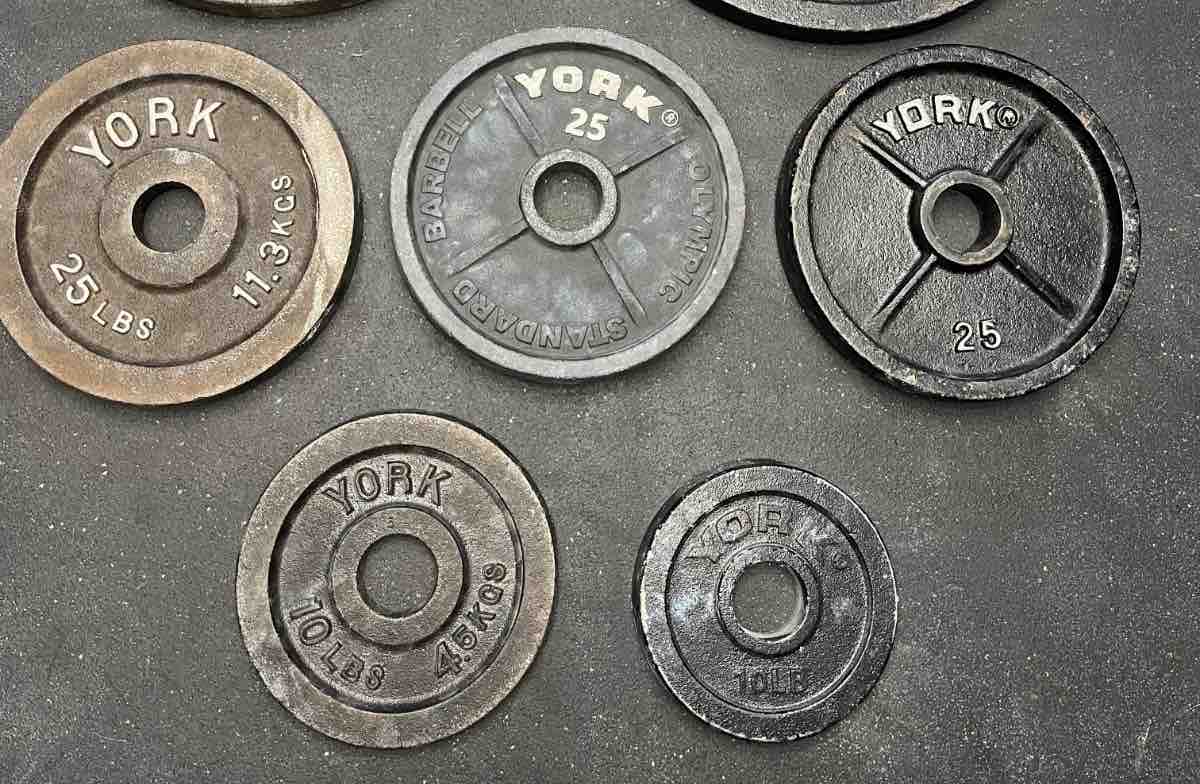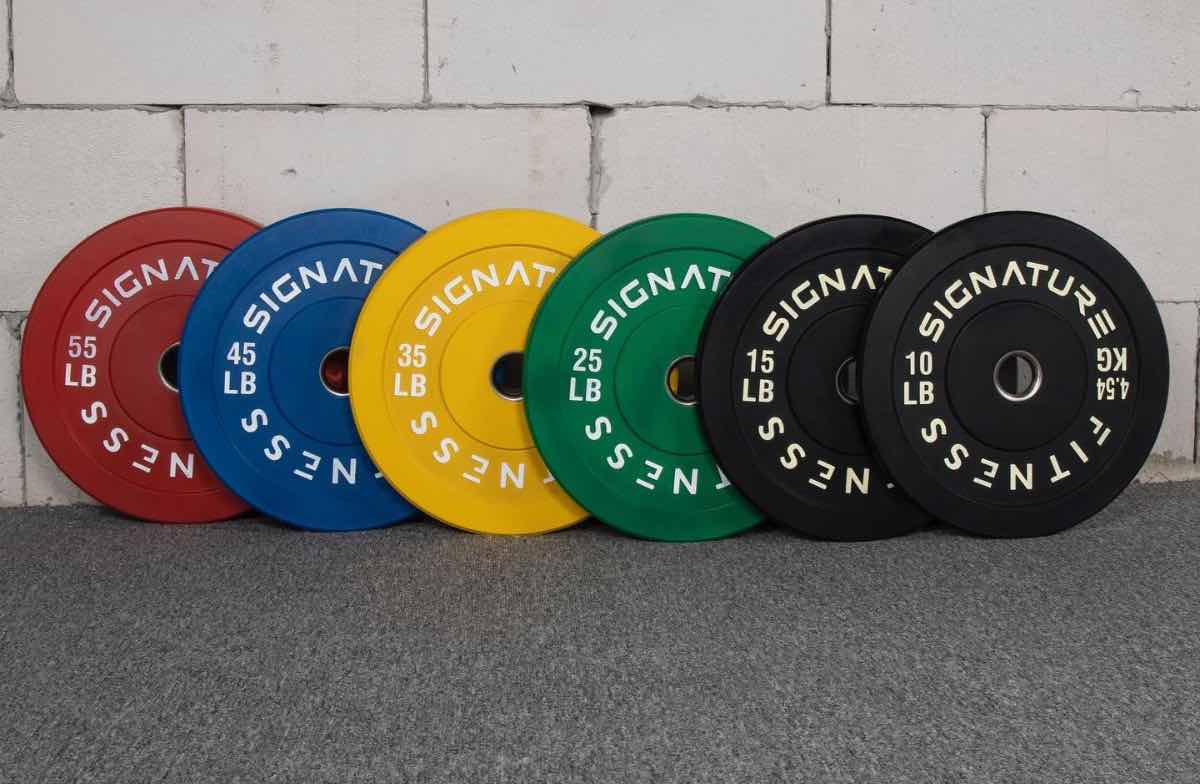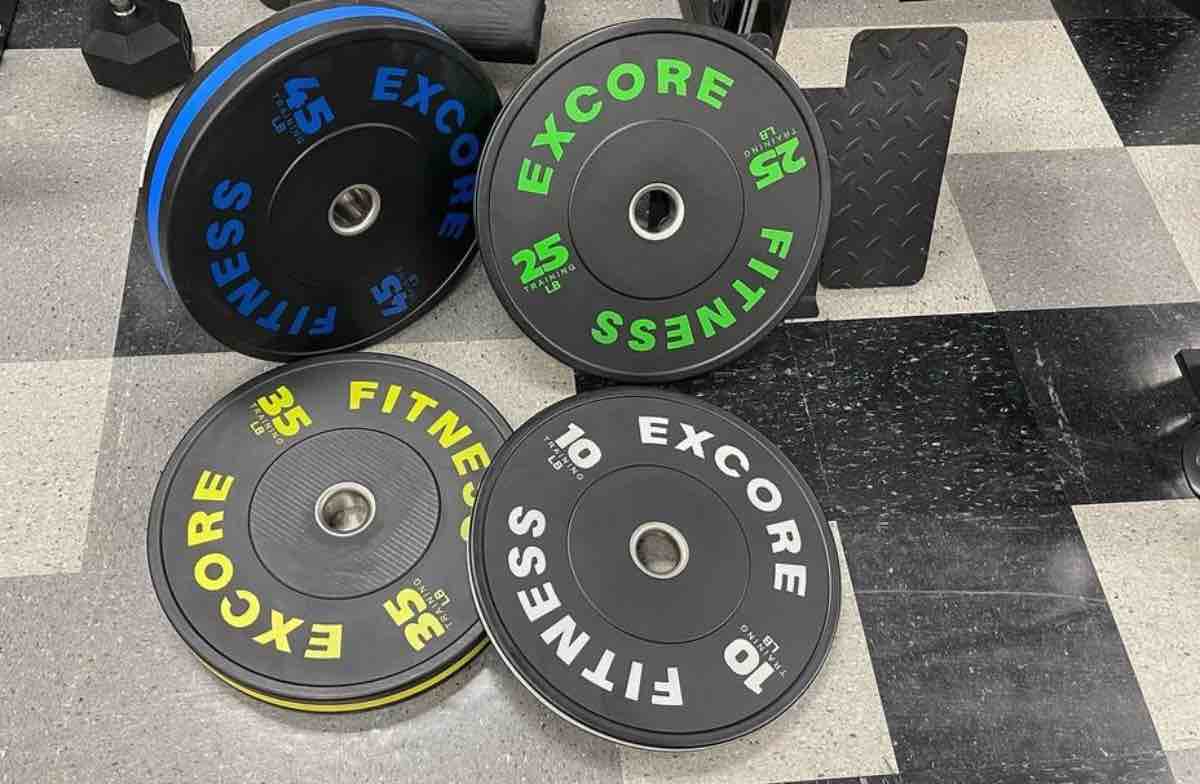If you’ve been lifting for years or are a beginner starting out, you might be wondering how many weight plates you’ll need for a home gym. The simple answer to that question is that it depends.
But if you’re in a hurry, here’s a quick answer.
In a basic home gym, you’ll need about 10 weight plates that range from 45lbs to 2.5lbs. Start with two plates of 45lbs, a pair of 25lbs, two 10lbs, a few 5lbs, and perhaps two 2.5lbs. This combination allows you to move between bar-only weight and a max weight of 220lbs. Proceed to add more 45lbs plates as your capacity increases.
However, the number of plates and individual weights may vary depending on your lifting experience and expertise.
Find out the best combination of weights you should get and how to maximize your workouts with existing plates by reading on.
How Many Weight Plates Do You Need
The standard collection of weight plates explained above works for most sessions. But fine-tuning your lifting regimen and relevant weight collection depend on various factors.
Let’s break down each element and see how they determine the number of weight plates you need.
How Much Do You Want to Be Able to Lift?

Start with a target weight that you want to hit eventually. This weight is not what you can lift right now. Rather, it’s what you hope to lift within a target period.
For instance, your lifting limit right now may be 200lbs off the bat. Perhaps you’d like to end the year with around 300lbs or more as your max for deadlifts. In this case, you may do better with a barbell and weight plates that weigh just above 300lbs.
The Standard Set of Weight Plates
For most lifters, the standard weight plates for a home gym can be:
- 2 x 2.5lbs,
- 2 x 5lbs
- 2x 10lbs
- 2 x 25lbs
- 2 x 35lbs
- and 2 x 45lbs.
However, how many plates you own may change depending on the type of weight plate preferred, the increase in lifting capacity, and the overall objective of your fitness journey.
Weight Plates for Beginners
Beginners can own the standard set recommended for a home gym. This set starts with a pair of each major weight plate (2.5lbs, 5lbs, 10lbs, 25lbs, 35lbs, and 45lbs).
Grab some additional 2.5lbs or 5lbs plates to add to your weight plate stand. By doing this, you’ll be able to achieve little but incremental gains in your weight-lifting workout.
Adding 45lbs plates to your existing bar will drastically increase the weight. But the 2.5lbs and 5lbs plates will allow you to fine-tune the exact weight levels that push your capacity.
Additionally, beginners might benefit from rubber weight plates instead of cast iron plates. Cast iron plates are sturdy, but they are easily damaged when dropped. Inexperienced lifters often struggle to lift heavier weights without dropping the bar.
Bumper weight plates will prevent floor damage and plate durability too.
Weight Plates for Intermediate Users
Once you have some lifting experience under your belt, you can proceed to experiment with more weight-training exercises. So, consider getting some additional weight stack.
Be careful not to rush into heavier plates immediately. However, intermediate users may benefit from an extra pair of 45lbs plates beyond the set recommended for a beginner.
Most commercial gyms have both starter plates and larger weights that can cater to lifters of any level. But your home gym typically has just enough weight to support your current regimen.
So, If you are an intermediate casual lifter, you may want to consider grabbing a few extra plates in both lighter (2.5lbs) and heavier (45lbs).
An intermediate casual lifter may move up with the 2.5lbs plates. On the other hand, there is still room to challenge yourself with the 45lbs plates.
Weight Plates for Advanced Users
Advanced users can aim to lift heavier through compound lifts and a more complex barbell setup.
So, bringing additional 45lbs plates to your collection is a good idea. But make sure you practice safe compound movements to prevent future injury.
At this point, you can try out an Olympic barbell. Also, an experienced lifter may make key considerations like the plates’ material density, technique plates, increasing your max lift, improving your form, lifting the bar efficiently, or experimenting beyond the standard barbell.
Do You Need 35 Pound Plates
After a specific point of expertise, you may not require the 35-pound plates. That’s because smaller plates allow for smaller increments, and heavier Olympic plates will increase your total weight.
Also, your home gym may have a smaller weight room compared to other spacious home gyms. So, selecting weight plates and gym equipment that occupy minimal space becomes vital.
The 35lbs plate is just a starting point for those who want to try out all the weights on a standard or Olympic bar. But once you’re beyond the beginner phase, the 45lbs and smaller weight plates serve as better weight plate sizes.
How Accurate are the Numbers on Weight Plates

Numbers on your weight plates are not 100% accurate every time.
So, expect a 2-3% variation between the indicated number and the total weight of the plate.
A basic 45lbs plate may have a real weight of 43lbs or go up to 49lbs in some cases.
What is the Weight of a Weight Plate Set
As listed above, the standard weight plate sets are (2 x 2.5lbs, 2 x 5lbs, 2 x 10lbs, 2 x 20lbs, 2 x 35lbs, and 2 x 45lbs) which will come to about 245lbs in total weight.
The overall weight loads on your weight stack may vary depending on individual variations in each plate.
For a beginner’s home gym, that’s sufficient for a decent bench press or deadlift. For more advanced lifters, iron plates may be preferred over bumper plates if they have enough room in their home gym.
Bumper Plates or Standard Plates
A bumper plate typically consists of rubber material that provides more safety for the user and the equipment. You can drop bumper plates on the floor, and they’ll absorb some of the impacts while preserving your home gym floor.
With cast iron plates, adding too many weight plates to Olympic bars can cause damage.
How to Determine How Many Weight Plates to Buy

Deciding how many weight plates to buy depends on your fitness goals, lifting targets, and overall lifting experience.
An advanced lifter using a weight cage may prefer to change plates often, while a beginner may use a trap bar with fewer plates and limited space.
If you’re getting started lifting weights, stick to the standard weight plates set and get your warm-up sets right. It is not as important to ask how many weight plates you need as it is to learn how to lift them.
Wrapping Up
Determining how much weight you can handle is not as easy as it sounds initially. Will you focus more on exercises like the bench press? Or prefer working with squat racks?
Maybe your garage gym can only accommodate limited plates. Or do you own one of those home gyms with wide spaces for workouts and storage?
The different shapes, sizes, and materials can confuse decisions on how many weight plates you need for a home gym.
Improve your decision with our guide on bumper plates vs. iron plates to get a better idea of which type suits you more.
FAQs
Why Do Weight Plates Only Go up to 45 Pounds?
Olympic plates weigh a maximum of 45lbs. So, manufacturers of weight plates also restrict the weights to the same limit. Even Olympic barbells top off at 45lbs, excepting some reasonable variation.
How do You Calculate Weight Plates?
Add the total pound plates attached to your bar and the barbell’s weight. For instance, most barbells will weigh 45lbs without plates. If you add a pair of 45lbs plates, the total weight comes to 135lbs.
Why do Iron Weights Feel Heavier?
It is common for gym enthusiasts to feel that iron weights are heavier compared to bumper plates.
This difference is often real because iron plates normally have more accurate weightage. On the other hand, bumper plates may be cheaper and exhibit more variation in real weight vs. supposed weight.
So, an iron plate showing 45lbs may measure 44lbs. The cheaper bumper plate showing 45lbs may have a real weight of 41lbs.
Do Rusted Weights Weigh More?
Rust is a result of oxidized metal. So, while the metal’s weight does not dramatically change, the added oxidized molecules add more weight to the material.
In short, rusted weights may have additional weight and are best avoided for intensive workouts.
What Kind of Weight Plates Should I Buy?
Start your weight-lifting journey with quality bumper plates that are safer. Later, you can move on to iron plates, which many advanced lifters prefer.
Avoid stacking your home gym with barbells that come with a vinyl plate. These cement-based plates will break down and deteriorate faster regardless of how many plates you buy for your home gym.
How Heavy are 2 Plates?
Two plates will weigh twice as much as the displayed weight if both are the same size.
For instance, two 45lbs plates will add a total of 90lbs, not including the barbell’s weight. Lighter weights like the 2.5lbs varieties will not add much weight variety to your barbell.
How Many 45lb Plates Fit on a Bar?
The number of 45lbs plates that fit on your bar will depend on its size, build, and length.
There are bars with 16.25-inch sleeves. These bars can hold almost ten 45lbs plates that are thinner than the standard. Trap bars and hex bars will not hold as many 45lbs plates.
How Much Weight Can You Put on a 1-inch Bar?
1-inch bars typically hold up to 250lbs on average. Of course, there are varieties that can hold more or comparatively less. So, check the bar’s manufacturing notes before pushing its holding limits

